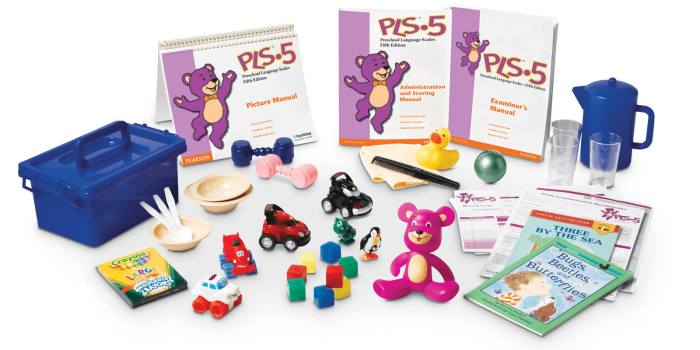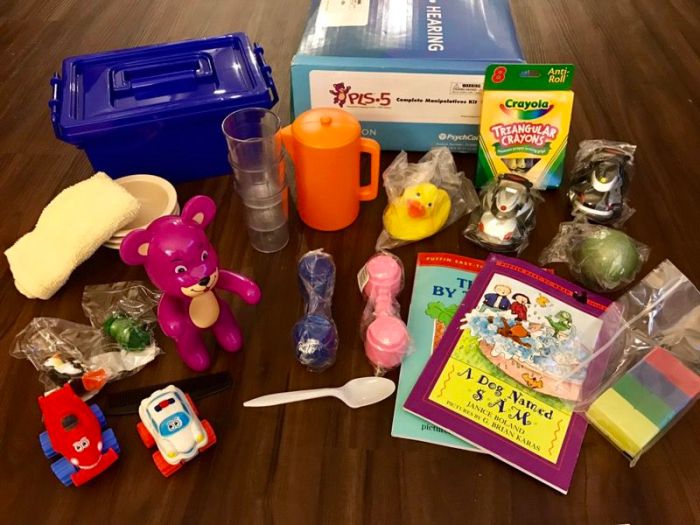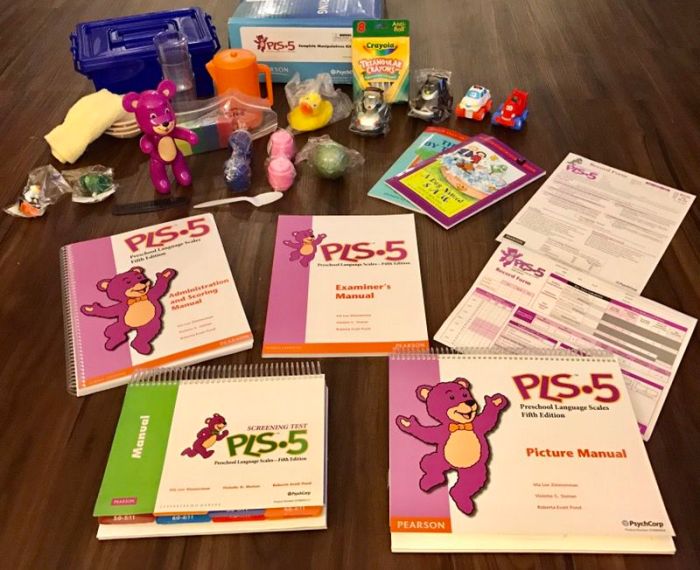Preschool language scale 5th edition – The Preschool Language Scale, 5th Edition (PLS-5) is a widely used tool for assessing language development in preschool children. It provides a comprehensive evaluation of a child’s receptive and expressive language skills, making it an invaluable resource for clinicians, educators, and researchers.
The PLS-5 is based on a sound theoretical framework and has undergone rigorous research and development. It has been standardized on a large sample of preschool children and has been shown to be reliable and valid.
Overview of the Preschool Language Scale, 5th Edition

The Preschool Language Scale, Fifth Edition (PLS-5) is a comprehensive assessment tool designed to evaluate the language skills of children between the ages of 2 and 6 years. It is widely used by speech-language pathologists, early childhood educators, and other professionals to identify children with language delays or disorders and to monitor their progress over time.
The PLS-5 is based on a theoretical framework that emphasizes the importance of both receptive and expressive language skills in children’s overall language development. It also recognizes the role of social-emotional factors in language learning.
History of the PLS-5
The PLS was first developed in 1986 by James B. Hale and Leslie J. Lewis. It has since undergone several revisions, with the fifth edition being published in 2012. The PLS-5 is the most current and comprehensive version of the assessment.
Key Components of the PLS-5
The PLS-5 is a comprehensive language assessment tool that consists of several sections, each designed to evaluate specific aspects of a child’s language abilities. The sections include:
Auditory Comprehension
The Auditory Comprehension section assesses the child’s ability to understand spoken language. It includes tasks such as following directions, answering questions, and identifying objects and actions. The tasks are presented in increasing levels of difficulty, and the child’s responses are scored based on their accuracy and completeness.
Expressive Communication, Preschool language scale 5th edition
The Expressive Communication section evaluates the child’s ability to produce spoken language. It includes tasks such as naming objects, describing actions, and telling stories. The tasks are presented in increasing levels of difficulty, and the child’s responses are scored based on their accuracy, complexity, and fluency.
Social Communication
The Social Communication section assesses the child’s ability to use language in social situations. It includes tasks such as initiating and maintaining conversations, asking and answering questions, and using appropriate nonverbal cues. The tasks are presented in increasing levels of difficulty, and the child’s responses are scored based on their appropriateness and effectiveness.
Scoring Procedures
Each section of the PLS-5 is scored using a standardized scoring system. The raw scores are then converted into scaled scores, which can be used to compare the child’s performance to other children of the same age.
Interpretation of Scores
The PLS-5 scores can be used to identify children who have language delays or disorders. They can also be used to track a child’s progress over time and to evaluate the effectiveness of intervention services.
Use of the PLS-5 in Practice
The PLS-5 is a valuable tool for assessing language development in preschool children. It can be used in a variety of clinical and educational settings, including:
- Speech-language pathology clinics:The PLS-5 can be used to assess the language skills of children who are suspected of having a language disorder.
- Early intervention programs:The PLS-5 can be used to assess the language skills of children who are at risk for developmental delays.
- Preschools and kindergartens:The PLS-5 can be used to screen children for language delays and to track their language development over time.
The PLS-5 has a number of strengths that make it a useful tool for assessing language development in preschool children. These strengths include:
- Comprehensive:The PLS-5 assesses a wide range of language skills, including vocabulary, grammar, and pragmatics.
- Standardized:The PLS-5 is a standardized test, which means that it is administered and scored in the same way every time.
- Reliable:The PLS-5 is a reliable test, which means that it produces consistent results when it is administered multiple times.
- Valid:The PLS-5 is a valid test, which means that it measures what it is supposed to measure.
The PLS-5 also has some limitations. These limitations include:
- Time-consuming:The PLS-5 can be a time-consuming test to administer, especially for children who have difficulty with language.
- May not be sensitive to subtle language differences:The PLS-5 may not be sensitive enough to detect subtle language differences in children who are typically developing.
Overall, the PLS-5 is a valuable tool for assessing language development in preschool children. It is a comprehensive, standardized, reliable, and valid test that can be used in a variety of clinical and educational settings.
Case Studies
The PLS-5 has been used in a number of research studies to assess language development in preschool children. For example, one study found that the PLS-5 was able to identify children with language disorders with a high degree of accuracy.
Another study found that the PLS-5 was able to track the language development of children over time. This study found that children who scored low on the PLS-5 at the beginning of the study made significant gains in their language skills over the course of the study.
Comparison with Other Language Assessment Tools
The Preschool Language Scale, 5th Edition (PLS-5) is one of several widely used language assessment tools for young children. While it shares some similarities with other tools, it also has unique features that make it suitable for specific assessment purposes.
The following table provides a comparison of the PLS-5 with other commonly used language assessment tools:
| Feature | PLS-5 | Other Language Assessment Tools |
|---|---|---|
| Age Range | Birth to 6 years | Varies depending on the tool |
| Language Domains Assessed | Comprehension, Production, and Use | May vary, but typically include some combination of comprehension, production, and use |
| Administration Time | Approximately 30-45 minutes | Varies depending on the tool |
| Scoring Method | Standardized scores based on normative data | May vary, but typically involve some form of standardized scoring |
| Reliability and Validity | High reliability and validity | Varies depending on the tool |
| Uses | Screening, diagnosis, intervention planning, progress monitoring | May vary depending on the tool |
Similarities and Differences
The PLS-5 shares several similarities with other language assessment tools, including:
- Assessment of multiple language domains (e.g., comprehension, production)
- Use of standardized scoring procedures
- High levels of reliability and validity
However, the PLS-5 also has some unique features that distinguish it from other tools:
- Age range: The PLS-5 can be used to assess children from birth to 6 years, making it a comprehensive tool for tracking language development over time.
- Language domains assessed: The PLS-5 assesses three specific language domains: comprehension, production, and use. This allows for a more detailed analysis of a child’s language abilities.
- Administration time: The PLS-5 is a relatively quick and easy-to-administer tool, taking approximately 30-45 minutes.
Choosing the Most Appropriate Tool
The choice of which language assessment tool to use will depend on the specific assessment purposes.
- Screening:For screening purposes, a tool that is quick and easy to administer, such as the PLS-5, may be appropriate.
- Diagnosis:For diagnostic purposes, a tool that provides a more detailed analysis of a child’s language abilities, such as the PLS-5, may be necessary.
- Intervention planning:For intervention planning, a tool that provides specific information about a child’s strengths and weaknesses, such as the PLS-5, can be helpful.
- Progress monitoring:For progress monitoring, a tool that can be used to track a child’s language development over time, such as the PLS-5, is essential.
By considering the specific assessment purposes, clinicians can choose the most appropriate language assessment tool for their needs.
Applications in Research

The PLS-5 has been widely used in research studies to investigate language development in preschool children. Researchers have employed the PLS-5 to examine various aspects of language, including vocabulary, grammar, and pragmatics. The findings from these studies have provided valuable insights into the typical and atypical language development trajectories of preschoolers.
Studies Using the PLS-5
- A study by Rescorla and Alley (2014) used the PLS-5 to investigate the relationship between early language skills and later reading achievement. They found that children with stronger language skills at preschool age were more likely to become successful readers in elementary school.
- Another study by Paul and colleagues (2015) used the PLS-5 to examine the impact of early intervention services on language development in children with developmental delays. They found that children who received early intervention services showed significant improvements in their language skills, as measured by the PLS-5.
These studies provide just a few examples of the many ways in which the PLS-5 has been used to investigate language development in preschool children. The findings from these studies have important implications for practice and policy, as they help us to better understand the factors that contribute to language development and the ways in which we can support children with language delays.
Future Directions in PLS-5 Research and Development: Preschool Language Scale 5th Edition

The PLS-5 has gained widespread recognition as a valuable tool for assessing language development in preschool children. However, ongoing research and advancements in the field of language assessment provide opportunities for future development and refinement of the PLS-5.One area for future research involves the expansion of the PLS-5’s normative sample.
Currently, the PLS-5 is standardized on a sample of children from the United States. Future research could explore the development of norms for different cultural and linguistic groups, ensuring the PLS-5’s applicability to a wider range of populations.Additionally, future research could focus on enhancing the PLS-5’s assessment of specific language skills.
For example, the PLS-5 could be revised to include more comprehensive measures of vocabulary, grammar, and discourse skills. This would allow for a more detailed analysis of children’s language abilities and support early identification of potential language difficulties.
Potential Improvements and Revisions
Potential improvements to the PLS-5 could include the development of a digital administration platform. This would allow for more efficient and convenient administration of the assessment, as well as the potential for real-time data analysis and reporting.Furthermore, revisions to the PLS-5’s scoring system could be explored to enhance its accuracy and reliability.
This could involve the development of more objective scoring criteria or the use of advanced statistical techniques to improve the precision of the assessment results.
Continued Contribution to Language Assessment
The PLS-5 has the potential to continue contributing significantly to the field of language assessment. Its strong psychometric properties and evidence-based approach make it a valuable tool for researchers and clinicians alike.Future research and development efforts will further enhance the PLS-5’s capabilities, ensuring its continued relevance and effectiveness in assessing the language development of preschool children.
FAQ Guide
What is the purpose of the PLS-5?
The PLS-5 is a tool for assessing language development in preschool children. It can be used to identify children who need additional support and to track their progress over time.
What are the key components of the PLS-5?
The PLS-5 has three main sections: the Receptive Language Scale, the Expressive Language Scale, and the Phonology Scale. The Receptive Language Scale assesses a child’s ability to understand language, the Expressive Language Scale assesses a child’s ability to produce language, and the Phonology Scale assesses a child’s ability to produce speech sounds.
How is the PLS-5 scored?
The PLS-5 is scored by a trained professional. The professional will administer the test to the child and then score the child’s responses. The child’s score will be based on the number of correct responses they give.
What are the strengths of the PLS-5?
The PLS-5 is a comprehensive, reliable, and valid measure of language development. It is also easy to administer and score.
What are the limitations of the PLS-5?
The PLS-5 is not a diagnostic tool. It cannot be used to diagnose a specific language disorder. Additionally, the PLS-5 is only available in English.